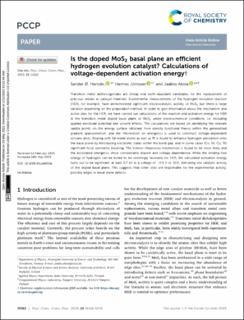| dc.contributor.author | Hanslin, Sander Øglænd | |
| dc.contributor.author | Jónsson, Hannes | |
| dc.contributor.author | Akola, Jaakko Eemeli | |
| dc.date.accessioned | 2024-02-19T08:26:06Z | |
| dc.date.available | 2024-02-19T08:26:06Z | |
| dc.date.created | 2023-06-09T14:41:34Z | |
| dc.date.issued | 2023 | |
| dc.identifier.citation | Physical Chemistry, Chemical Physics - PCCP. 2023, 25 (22), . | en_US |
| dc.identifier.issn | 1463-9076 | |
| dc.identifier.uri | https://hdl.handle.net/11250/3118358 | |
| dc.description.abstract | Transition metal dichalcogenides are cheap and earth-abundant candidates for the replacement of precious metals as catalyst materials. Experimental measurements of the hydrogen evolution reaction (HER), for example, have demonstrated significant electrocatalytic activity of MoS2 but there is large variation depending on the preparation method. In order to gain information about the mechanism and active sites for the HER, we have carried out calculations of the reaction and activation energy for HER at the transition metal doped basal plane of MoS2 under electrochemical conditions, i.e. including applied electrode potential and solvent effects. The calculations are based on identifying the relevant saddle points on the energy surface obtained from density functional theory within the generalized gradient approximation, and the information on energetics is used to construct voltage-dependent volcano plots. Doping with 3d-metal atoms as well as Pt is found to enhance hydrogen adsorption onto the basal plane by introducing electronic states within the band gap, and in some cases (Co, Ni, Cu, Pt) significant local symmetry breaking. The Volmer–Heyrovsky mechanism is found to be most likely and the associated energetics show considerable dopant and voltage-dependence. While the binding free energy of hydrogen can be tuned to be seemingly favorable for HER, the calculated activation energy turns out to be significant, at least 0.7 eV at a voltage of −0.5 V vs. SHE, indicating low catalytic activity of the doped basal plane. This suggests that other sites are responsible for the experimental activity, possibly edges or basal plane defects. | en_US |
| dc.language.iso | eng | en_US |
| dc.publisher | Royal Society of Chemistry Publishing | en_US |
| dc.rights | Navngivelse 4.0 Internasjonal | * |
| dc.rights.uri | http://creativecommons.org/licenses/by/4.0/deed.no | * |
| dc.title | Is the doped MoS2 basal plane an efficient hydrogen evolution catalyst? Calculations of voltage-dependent activation energy | en_US |
| dc.title.alternative | Is the doped MoS2 basal plane an efficient hydrogen evolution catalyst? Calculations of voltage-dependent activation energy | en_US |
| dc.type | Peer reviewed | en_US |
| dc.type | Journal article | en_US |
| dc.description.version | publishedVersion | en_US |
| dc.source.pagenumber | 11 | en_US |
| dc.source.volume | 25 | en_US |
| dc.source.journal | Physical Chemistry, Chemical Physics - PCCP | en_US |
| dc.source.issue | 22 | en_US |
| dc.identifier.doi | 10.1039/d3cp00516j | |
| dc.identifier.cristin | 2153354 | |
| dc.relation.project | Sigma2: NN9497K | en_US |
| cristin.ispublished | true | |
| cristin.fulltext | original | |
| cristin.qualitycode | 2 | |

